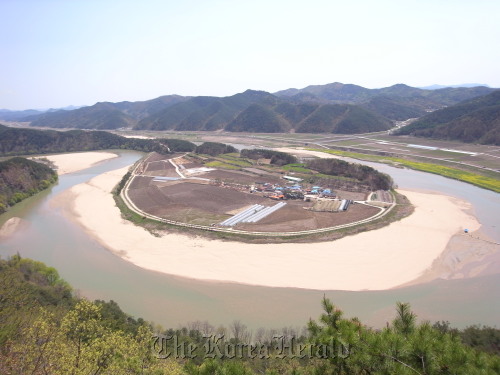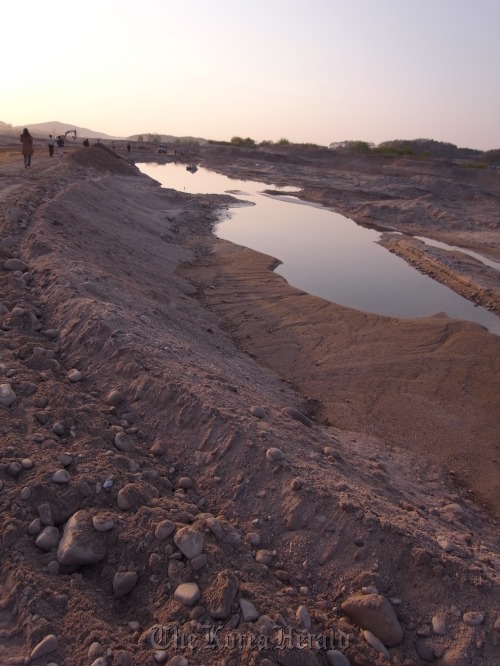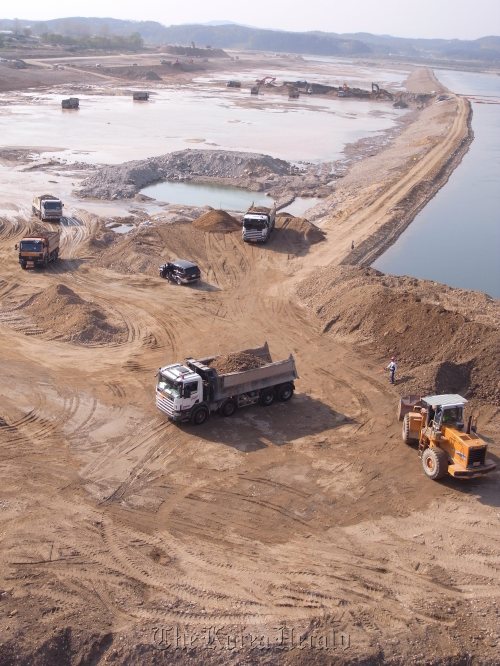YECHEON, North Gyeongsang Province/YEOJU, Gyeonggi Province -- Hoeryongpo, about three-hour drive south of Seoul, is a small village where a dragon-like lake twists and turns around the houses and trees.

A lake twists and turns around Hoeryongpo, a village in North Gyeongsang Province
The river’s century-old sedimentation activities have created a sandy plain surrounding the town, which has become a habitat for migratory birds and plants.
“This unique landscape may not be found in Korea any more,” said Lee Won-young, professor of urban planning at the University of Suwon, while looking at the village from the observatory last week.
As part of the government’s Four Major Rivers Restoration Project, construction is underway for dredging and damming the Nakdong River, which runs through the eastern part of the country.
When one of the planned dams is completed in the upper stream of Naesungcheon, a tributary of the Nakdong River, the professor said, less sand will flow into the waters surrounding the village and will change the ecology of the area.
“The sand in the Korean Peninsula, mostly from granite, filters water through the space between grains. In particular, the sandy plains, frequently spotted along the Nakdong River, provide a perfect habitat for wildlife,” Lee said.
“However, I heard a government official described the sandy plains as thick layer of fat that should be removed while promoting the river project.”
Costliest project
Amid fierce resistance from environmentalists and opposition parties, the government launched the river project in November, aimed at improving water quality and preventing natural disasters along the Han, Nakdong, Geum and Yeongsan rivers.
The government also estimates the project will create 340,000 jobs and 38 trillion won ($34 billion) in long-term economic benefits.
With a combined 22.2 trillion won ($20 billion) injected from public funds, the river project is expected to become the costliest engineering work in the nation’s history.
It is also a core project of the “Green New Deal” policy pushed by the Lee Myung-bak administration. The government plans to complete the construction work by 2012 before Lee’s five-year term ends in 2013.
According to the Ministry of Land, Transport and Maritime Affairs, the construction work on a total of 16 dams were on average 12.2 percent complete as of Monday.
The ministry said 60 percent of the main projects including building dams will be completed within the year.
With social and political controversies over the project deepening, the National Election Commission ordered a halt to the ministry’s promotion of the project, warning that the issue could affect the local elections next month.
Environmental study
On a construction site in Yeoju, Gyeonggi Province, reporters were introduced to a habitat of a rare type of chrysanthemum, which was found late last month during construction work.
Even though the endangered species, called “Aster altaicus var. uchiyamae,” is believed to grow only along the South Han River, the Yeoju area was omitted from the feasibility study conducted by the Ministry of Environment.
Despite a local environmental office’s order to halt the project in the area, the construction work was still underway on Sunday.
While the main community of the species was surrounded by a boundary line, some of them were moved to another place for transplant.

A construction site on the South Han River
Their originally green leaves had turned brown. An official from the Korean Water Resources Corporation said “they were adapting to the new environment.”
“Almost half of rare species extinctions are caused as their habitat is changed. For the accurate study on them, they should be monitored every year over the long term,” said Jeung Min-gull, an ecological geneticist at Kongju National University in Gongju.
“The nation lacks specialists in the field and related infrastructure. That’s why we need enough time to conduct such a large-scale environmental study,” he said.
For the river project, the government omitted the preliminary investigation and completed the feasibility study within about four months.
Academics join fight
Jeung, the professor, participated in the environmental review panel on the river project. However, he quit the job after having found that the study was aimed at offering advice, not pointing out problems to change. Then, he joined a group of professors who fight against the river project.
The Professors’ Organization for Movement Against Grand Korean Canal was formed two years ago in protest against one of President Lee’s campaign pledges to develop a pan Korean waterway by connecting the Han and Nakdong rivers.

Dredging work underway along the Nakdong River
Even though the president withdrew his canal plan after taking office in February 2008, the group with a membership of some 2,500 professors has led the campaign against the river project, assessing the environmental and economic impacts of the plans and offering information to the public.
“We have recognized our negligence painfully. If we had spoken of the environmental importance of our rivers from 20 years ago, people would never have accepted this flawed project today,” said Lee of Suwon University.
Jeung showed some old photos of the Han River in Seoul in which a sandy river bank was crowded with citizens.
“Other countries such as Switzerland and Germany are breaking concrete dams and other artificial facilities to restore the natural beauty of the riverside. But the nation’s river project is bucking the global trend, isolating people from the rivers,” he said.
By Lee Ji-yoon (
jylee@heraldcorp.com)








